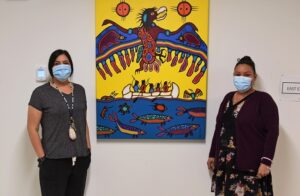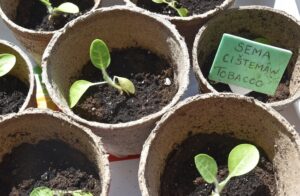The North Bay Indigenous Hub sees continued success throughout the pandemic

By Kelly Anne Smith
NORTH BAY— The timing was right for staff of the North Bay Indigenous Hub (NBIH) to be front-line helpers during the coronavirus disease 2019 (COVID-19) pandemic.
Helping parents and their children and elders and their families, the Hub had been rewarded with great feedback from offering services to Indigenous people in the North Bay and surrounding area during these challenging times.
Renovating the building to what is now, the North Bay Indigenous Hub, resulted in a warm, professional and stylish transformation. Indigenous art by Dan Commanda hangs on the walls in the reception area. The reception desk features art by Kathryn Corbiere of One KWE. There are three metal signs; Biindgen, Welcome and Pihtokew. Biindgen is Anishinaabemowin for welcome, while Pihtokew is Cree for welcome.

The tour through the Traditional Healing Department was aromatherapy of the best kind. The department grows and gathers traditional medicines including Semaa, Anishinaabemowin for tobacco or Cistamaw in Cree.
The Hub offers many services with Indigenous approaches including primary health care, daycare and an EarlyON Centre. With different COVID-19 safety guidelines, opening programs to the public has had different timelines.
Executive Director Lauree Linklater-Pizzale explains the new coronavirus that causes COVID-19 has limited services for Dokis First Nation and Temagami First Nation. Nipissing First Nation is also partnered with the NBIH.
“We’ve reached out to them to see what their needs are. We offered them virtual visits and any supplies that were needed to keep them safe as well as pandemic planning. We sent wipes, hand-sanitizer, masks, shields and gowns to each First Nation.”
As the Government of Ontario enters the third stage of reopening the province, the NBIH Daycare is open. Children’s laughter can be heard on the other side of the fence. The children have a big green space and enjoy a traditional medicine garden. Cedar trees grow to provide both medicine and shade.
The NBIH has invited children on a staggered basis for safety says Linklater-Pizzale.
“We want to limit the amount of people through the doors with tours. We are going through our waitlist. It’s exciting!” says Linklater-Pizzale. “Looking outside and seeing the kids play— it’s just amazing. They are doing wonderful things to deliver services in the way that we need them— grounded in our culture. It’s foundational and meaningful. We are doing language downstairs. We are doing drumming downstairs. It’s unique in an urban setting and I’m happy to be supporting that.”
Linklater-Pizzale adds the NBIH daycare has space for both Indigenous and non-Indigenous children.
“Non-Indigenous children can learn about our culture and grow up with that respect and support allyship. Building those relationships is important.”
Connections are being made with Elders, too. At the start of the pandemic, NIHB introduced Mino-Bimaadiziwin Baskets, which were distributed for 10 weeks. Linklater-Pizzale says the baskets started at the beginning of the pandemic state-of-emergency.
“We recognized they (Elders) were the most vulnerable population to be exposed to the virus. We thought of ways to best limit their exposure with going out into the community to get their basic needs. Nipissing First Nation had done that for their own community,” Linklater-Pizzale explains. “For the community of North Bay, we have quite a few Indigenous people from all over. We wanted to make sure we could help them out as much as we could.”
Linklater-Pizzale explains The Traditional Healing Department included traditional medicines in the baskets.
“That was an overwhelming great response. Every week it was checked off. We had approximately 23 Elders and their families. The way our communities are, we have Elders who have taken in their grandchildren. It helped out a lot.”
She says people looked forward to engaging with the NBIH during the program.
“Even though it was a contactless drop, they looked forward to seeing staff and waving at them through the window. And talking on the phone with their food requests – it was more about that conversation. ‘How are you doing? What is going on?’ They would talk about how no one came by this week and that it’s nice to hear a voice. Yearning or longing for some kind of exchange of social networks, they are missing that during this period and it’s so important,” says Linklater-Pizzale. “We ended up putting a note in their basket saying, ‘If you ever need to speak to somebody, here’s the number.’ I think they relied on that Elder’s basket exchange as one of their weekly check-ins.”
Linklater-Pizzale notes the pandemic has people reaching out virtually, especially NBIH on Facebook.
“We had a couple of programs that ran through COVID-19 Phase 1 and 2, which allowed for people to move. We had the running challenge with 55 participants. Everybody had their own goals. Whether it was you walk to run, or you achieve a distance, or you lost weight or you feel better,” she explains. “The safest place for people to be and practice social distancing and do all the protective measures is being outside. We had a scavenger hunt that ran for four weeks. We asked for photos from nature. For example, from your yard, show something that is in bloom or name that tree. One of the Elders that participated said it gave her an opportunity to be outside. Although everyone was in isolation, she was able to connect with the land and the program and feel good about it.”


